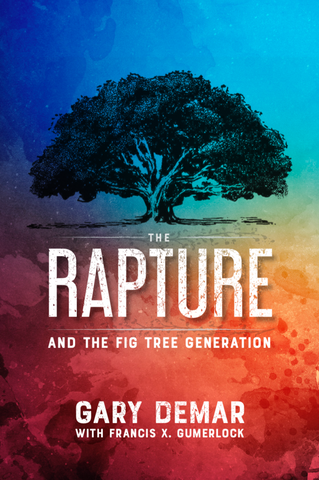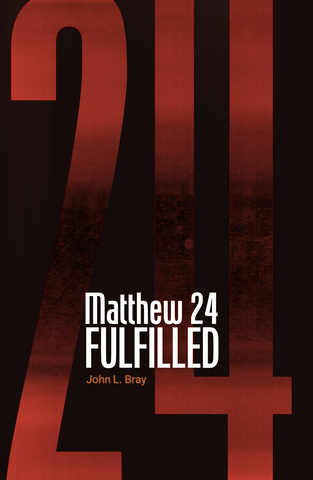Ron Rhodes appeals to Revelation 3:10 to support the pre-trib rapture view in his book Bible Prophecy Under Siege. (See Parts One and Two) Here’s what he has to say in support of his view:
This verse reveals that church saints will be kept from the actual time period of testing, not just the testing itself…. That Revelation 3:10 refers to a rapture before this future period of worldwide testing is implied in verse 11: “I am coming soon. Hold fast what you have, so that no one may seize your crown.” The phrase “I am coming soon” apparently refers to the imminence of the rapture….” (195)
There’s so much wrong with his explanation that I don’t know where to begin. First, note that he uses the phrase “church saints.” John is not referring to a distant worldwide church just before its rapture. I dealt with this earlier. The churches of that time are the audience.
Second, notice how he applies the meaning of “soon … to the imminence of the rapture.” Wait a minute! Didn’t Rhodes tell us that “soon” in Revelation doesn’t really mean “soon” as the word is normally understood? Suddenly “soon” does mean “soon” for Rhodes. His view is that when these prophetic events occur, they “will all happen quickly!” (97). As we saw in a previous article, that’s not how the word tachos is used elsewhere in the NT. Also note that he uses the word “apparently” because nothing is said about the church being taken to heaven in the “rapture.” He reads into the passage unproven assumptions.

The Rapture and the Fig Tree Generation
Since the national reestablishment of Israel in 1948, countless books and pamphlets have been written defending the doctrine assuring readers that it could happen at any moment. Some prophecy writers claimed the “rapture” would take place before 1988. We are far removed from that date. Where are we in God’s prophetic timetable?
Buy NowThird, he says this period of testing is global. Where does it state that? You might say, “It’s right there in the text: ‘the whole world.’” Revelation 3:10 does not use the Greek word kosmos but oikoumenē. The use of oikoumenē instead of kosmos indicates that the events that were about to unfold were confined to the political boundaries of the Roman Empire. Oikoumenē is used many times in the NT and refers to limited geography. Rome didn’t and couldn’t tax the “whole world” (Luke 2:1), and it’s highly unlikely that there was a famine over the entire planet at that time (Acts 11:28). That’s why Luke uses oikoumenē in both places. The men preaching the gospel in Thessalonica did not “upset the world” as we know it today. It was a segment of the world (oikoumenē)—their world—that the gospel was spreading through (17:6). We know this because they were charged with acting “contrary to the decrees of Caesar, saying that there is another king, Jesus” (17:7). This should remind you of the fear the birth of Jesus had on Herod when the wide men asked, “Where is the baby born to be the king of the Jews?” (Matt. 2).
Fourth, the Greek word mellō, “about to,” is used. As we saw, the same word is used in Rev. 1:19 and 2:10. Latin scholar Francis X. Gumerlock writes that “many comments from medieval commentaries … attributed the ‘tribulation coming upon the whole earth’(Rev. 3:10) to the persecution of Christians in the early church, rather than a great tribulation at the end of the world. … ‘On Rev. 3:10, about the “hour of testing” or [sic] tribulation coming upon the whole earth,’ Ralph of Laon, Hugh of Saint Cher, and Nicholas of Gorran interpreted it as a time of testing that immediately followed the emperor Nero, who died in 68 A.D.”
The following is from Moses Stuart’s two-volume commentary on Revelation:
Μελλούσης ἔρχεσθαι [mellousēs erxesthai], is about to come, or which is speedily coming; for so μέλλω usually signifies, being employed to designate the proximate future. —Οἰκουμένην ὅλης [oikoumenēn holēs], the whole world [oikoumenē]; comp. πάσαν τὴν οἱκουμένην [pasan tēn oikoumenēn] in Luke 2:1, where possibly it means Judea, but probably the whole Roman empire. At any rate, the phrase is often used indefinitely for a wide extent of country; and so it may designate the whole Roman empire. Here the most probable meaning is the same, or at least the whole region of the Roman Asia Minor, or the whole country around the region of Philadelphia…. Γῆς[gēs, land] is most evidently here synonymous with οἰκουμένης ὅλης [oikoumenēs holēs/whole inhabited world]; and κατοικοῦντας ἐπὶ τῆς γῆς [katoikountas epi tēs gēs] dwelling upon the land: Rev. 11:10; 17:2, 8]; is a common Hebraistic idiom for designating the inhabitants of a country.[1]
Fifth, note the use of “quickly” or “soon” in Revelation 3:11. If this has not happened, then how was this a warning to “the churches” in John’s day?[2] How would the people in those seven churches have understood what they read? Why wouldn’t they have applied it to themselves? Notice the use of “the hour of testing.” John wrote the following in 1 John 2:18:
Children, it is the last hour; and just as you heard that antichrist is coming, even now many antichrists have appeared; from this we know that it is the last hour.
If these refer to the same “hour,” then that hour is past because Revelation was written before the destruction of Jerusalem that took place in AD 70, and John wrote, “It is the last hour.” Not the last hour of the end of the world but end of the impending judgment Jesus mentioned in the Olivet Discourse and elsewhere. The generation was known (their generation), but the “day and the hour” were not known (Matt. 24:34-36).
After tachos, Rhodes mentions the Greek word engus which means “near” or “at hand.” Once again, instead of considering how engus is used elsewhere in the NT, Rhodes appeals to some of his dispensational colleagues like Norman Geisler and Mark Hitchcock. Geisler states that engus “is a relative term like ‘short’ and ‘long.’” He continues with, “there are clear biblical examples where a ‘short’ time was really a long time for us. Hebrews 10:37 says Jesus would come in just ‘a little while,’ and it has been nearly 2000 years since then, and He has not come yet.” (97) “A short time was really a long time.” Really? And what is typical, when the consistent use of “near” doesn’t fit their system, an appeal is made to 2 Peter 3:8, “what is long for us is short for God,” as Geisler puts it. Hebrews 10:37 is very emphatic : “very, very little” (μικρὸν ὅσον ὅσον/mikron hoson hoson). Compare this with what Jesus says to His disciples:
“A little while, and you no longer are going to see Me; and again a little while, and you will see Me.” So some of His disciples said to one another, “What is this that He is telling us, ‘A little while, and you are not going to see Me; and again a little while, and you will see Me’; and, ‘because I am going to the Father’?” So they were saying, “What is this that He says, ‘A little while’? We do not know what He is talking about.” Jesus knew that they wanted to question Him, and He said to them, “Are you deliberating together about this, that I said, ‘A little while, and you are not going to see Me, and again a little while, and you will see Me’?” (John 16:16-22).
Jesus would be crucified and buried, but He would be raised from the dead, and His disciples would see Him again after His resurrection. “Little while” is not relativized.

Matthew 24 Fulfilled
In his book, Southern Baptist Reverend John Bray states: "Present-day students of eschatology seem woefully ignorant of the writings of past theologians on these subjects. There was a time (prior to the mid-1800s) when the most prominent interpretation of Matthew 24 was from the preterite standpoint, and the dating of Revelation was believed to be at an earlier date than is now believed." Grasp what this book teaches, and you won't waste any more of your time on the pre-mil, pre-trib fiction put out by the so-called "prophecy experts." Matthew 24 Fulfilled examines the issues related to popular "end-times" hysteria and counters with a view consistent with all of Scripture.
Buy NowHebrews 10:37 described what was on the horizon for that generation. The author of Hebrews mentions he “who has trampled under foot the Son of God and has regarded as unclean the blood of the covenant by which he was sanctified and has insulted the Spirt of grace” (10:29). This is reminiscent of what we read in Acts 2:23 with Peter’s message to his Jewish audience (2:5): “you nailed to a cross by the hands of godless men and put Him to death.” In Hebrews 10:30 we find, “the Lord will judge His people.” Also see 1 Corinthians 2:6-8 and Matthew 23:31-36. The author of Hebrews is not describing some distant relativized generation. John Owen offers this comment:
Of the first sort were the Jews, who slew him, who murdered him, and cast him out of the vineyard, and thereon continued their hatred against the gospel and all that made profession thereof. He was to come to “destroy those murderers, and to burn their city” [Matt. 22:7]; which fell out not long after the writing of this epistle, and is properly intended in this place. See Matthew 24:3; Matthew 24:27; Matthew 24:30; 2 Peter 3:4; Jude 1:14; Revelation 1:7; Mark 14:62; James 5:7-8. For hereon ensued the deliverance of the church from the rage and persecution of the Jews, with the illustrious propagation of the gospel throughout the world.
I’ll add the comments of John Brown from his well-respected commentary on Hebrews republished by The Banner of Truth Trust and recommended as one of the finest commentaries on Hebrews:
It cannot refer to His first coming in the flesh, for that was already past. It cannot refer to His second coming in the flesh, for that is even yet future, after the lapse of nearly eighteen centuries; whereas the coming here mentioned was a coming just at hand. But though these are the only comes of the Son of God in the flesh, they are by no means the only comings that are mentioned in Scripture: His coming in the dispensation of the Holy Spirit; and His coming for the destruction of His Jewish enemies, and the deliverance of His persecuted people…. [As to] the second, in Matt. xxiv. 27: “For as the lightning cometh out of the east, and shineth even unto the west; so shall also the coming of the Son of man be.” It is the last of these that there is a reference in the passage before us. Jesus Christ had promised, that when He came to execute vengeance on His enemies of the Jewish nation, His friends should not only be preserved from the calamity, but obtain deliverance from their persecutions: “When these things begin to come to pass, then look up, and lift up your heads; for your redemption draweth nigh” [Luke 21:28]. This coming was to take place before that generation passed away [Matt. 24:34]. More than thirty years had already elapsed; and within eight or nine years—“a little while”—the prediction was accomplished.[3]
J. Stuart Russell references commentators whose interpretations are like those of John Brown. While Jesus uses the Greek word mikron (little) for something that was to happen soon (John), we find in Hebrews 10:37 using very, very, little while “and will not delay”:
This statement looks in the same direction as the preceding. The phrase, ‘he that shall come’ [ὁ ἐρχόμενος] is the customary designation of the Messiah,—‘the coming One.’ That coming was now at hand. The language to this effect is far more expressive of the nearness of the time in the Greek than in English: ‘Yet a very, very little while;’ or, as Tregelles renders it, ‘A little while, how little, how little!’ The reduplication of the thought in the close of the verse,—‘will come, and will not tarry,’ is also indicative of the certainty and speed of the approaching event. Moses Stuart’s comment on this passage is,— ‘The Messiah will speedily come, and, by destroying the Jewish power, put an end to the sufferings which your persecutors inflict upon you,’ comp. Matt. xxiv.’[4] This is only part of the truth; the Parousia brought much more than this to the people of God, if we are to believe the assurances of the inspired apostles of Christ.[5]
And from Henry Cowles 1878 commentary, “The time is indeed very short, this time of your trial; for when, under the sweep of terrific judgments, the proud city Jerusalem shall fall, all persecution from bigoted Jews will cease. Even now the signs suffice to show that her day of judgment is near, and can not tarry long.”[6]
[1] Moses Stuart, Commentary on the Apocalypse, 2 vols. (New York: Allen, Morrill and Wardwell, 1845), 2:94-95.
[2] “But this coming can not be the final one or the last judgment, because that coming was then certainly remote, and Jesus never indicated the time when it should occur (Mark 13:32). For reasons more fully given in my notes on 1:7, it may be supposed to refer somewhat definitely to Christ’s coming to destroy Jerusalem, considered as the first great persecuting anti-Christian power, the general thought being—I am about to make special manifestations of my presence and power in retributive vengeance on the present persecutors of my people, and also forthe salvation of my faithful friends.—This coming will be an hour of crisis and of stern conflict: therefore hold fast thy profession; stand firmly for Jesus; a few days of terrible struggle —and then, if faithful, thy crown is made sure; but one hour’s apostasy will be at the cost of thy crown!” Cowles, The Revelation of John, 80.
[3] John Brown, An Exposition of Hebrews (1862), 484-485.
[4] Moses Stuart, Commentary on the Epistle to the Hebrews, 2nd ed. (New York: Flagg, Gould, and Newman, 1833), 481.
[5] The Parousia: The New Testament Doctrine of Our Lord’s Second Coming (Grand Rapids, MI: Baker Books, [1897] 1983), 274-275.
[6] The Epistles to the Hebrews (New York: D. Appleton, and Company, 1878), 108.

